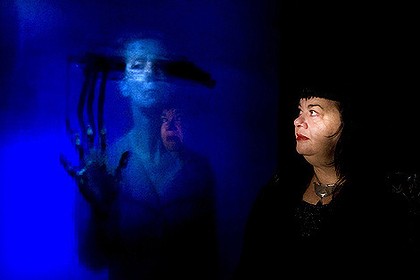
A viewer with an interactive video by Lynette Wallworth, Invisible by Night, commissioned by the Melbourne Festival 2004.
Photo via: forma.org.uk.
All artnet News wanted to do was look up a few satellite events at this year’s annual meeting of the World Economic Forum in Davos-Klosters, Switzerland.
The meeting begins officially on January 21st and runs until the 24th, and it is true that some of the movers and shakers who gather “in the spirit of global citizenship” actually do take an interest in the arts.
For example, we note that at last year’s meeting the Iranian-born artist and intellectual Shirin Neshat was one of four recipients of a Crystal Award, which, according to Bloomberg Businessweek, “honors artists who have made important contributions to improving the state of the world.” (For more about Shirin Neshat, see the artnet News article Shirin Neshat Discusses Her Series Our House is on Fire.)
After surfing around the World Economic Forum’s website and stopping briefly at an article about gender parity (“Q&A: What is the future of fatherhood?”—shared on Twitter 235 times, as of publication time) and one about factory-style livestock production (“2 ways to fix factory farming”—shared on Twitter, alas, zero times, as of publication time), artnet News landed in a good spot: on a January 7, 2015, article titled “Why do we bring artists to Davos?” (The article is part of a series co-produced by the Huffington Post and the World Economic Forum.) The author is Nico Daswani, head of arts and culture for the programme development team at the World Economic Forum.
The final two paragraphs of Mr. Daswani’s article read:
The arts activities in Davos may or may not have tangible outcomes. A performance may only provide hope, or an installation only a slight sense of discomfort. How will participants react to [Australian] Lynette Wallworth’s immersive “Evolution of Fearlessness,” a set of moving and interactive portraits of women refugees [who have lived through extreme acts of violence], which celebrates resilience in the hardest conditions—this in the context of the worst refugee crisis ever recorded?
We will not prescribe solutions. It is not the role of the arts. But we will trust in the potential of the experiences, in the context of how they are presented and contextualized within the Annual Meeting, to spark a new idea, create more empathy, shift a consciousness, and even lead a leader to commit to action. None of this is efficient nor scalable; but then again change has never come easily.
Wallworth’s interactive video—which allows participants to use “video touch”—is presented by the World Economic Forum as part of a focus on refugees.
Congress Delegates can meet Lynette Wallworth at a Meet the Artist event on January 21, from 1.45–2 PM on the Lower Level of the Congress Centre. Congress Delegates can also see Wallworth at an In Conversation: Visions of Storytelling event with the photographer Platon on January 22, from 9–10 AM at the Congress Centre – Schwarzhorn BetaZone.